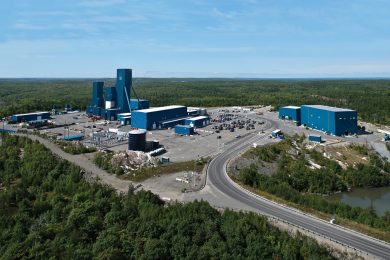Glencore is moving ahead with a $700 million development of its Onaping Depth nickel-copper project in the Sudbury Basin, which along with Goldcorp’s Borden gold mine and Kirkland Lake Gold’s Macassa and Taylor mines, will be one of the first all electric mines in the world. Onaping Depth is a large, high-grade resource basin which is accessible from the existing Craig mine infrastructure.
According to a March 2 report in Northern Ontario Business, the project includes the construction of a winze from the 1,200 m level laterally off the workings of Craig mine to access some 14 million tonnes of ore 2,500 m from surface. The first 700 m of the winze will be raisebored down to the 1,900 m level and then slashed and extended beyond that to the 2650-metre level using conventional shaft sinking technology. The project also includes all off-shaft development and associated ore handling systems. First production from Onaping Depth will occur in 2023 and full production by 2025. Glencore needs the ore to replace declining reserves at its Nickel Rim South and Fraser Mines. “Mining at Nickel Rim South is scheduled to cease in 2022,” Peter Xavier, Vice President of Glencore’s Sudbury Integrated Nickel Operations told Northern Ontario Business. “Fraser Mine goes a little further to 2024-2025, so Onaping Depth will come in at a time when existing mines are tailing off and secures our business here in Sudbury well into the 2030s.”
Glencore has committed to an all-electric mining fleet for Onaping Depth. “Mines at depth require a large volume of air for ventilation in a typical diesel arrangement, and that air has to be heated in winter and cooled at depth, so the capital cost of the infrastructure and the operating costs for all that are quite substantial,” said Xavier to Northern Ontario Business. “Also, ventilation requirements constrain most mines to some degree in terms of the operating activities you can undertake at any given time, so moving to an all-electric fleet will allow us to change that in our favour.”
Less air will also reduce the number and size of openings necessary to deliver it underground and return it to surface. Onaping Depth will be operated in the same way as a modern manufacturing plant with mine-wide WiFi enabling real-time information flow and better decision-making. Xavier and his team are also looking at other technologies and innovations, including automation and more continuous methods of mining that will remove miners from underground hazards. Replacing traditional drill and blast technology with cutting is also a possibility. According to Xavier, several large OEMs have developed tunnel-boring prototypes for hard rock applications, and Glencore is working with other mining companies under non-disclosure agreements to evaluate them. “Technology and innovation happen quite fast, so between now and 2025, there could be things that come available that we can take advantage of.”
Xavier is confident that a full range of electric vehicles will be available in time for startup, including the big prime movers – 14 t scoops and 40+ t trucks. “The major OEMs have them in their pipeline, but we won’t need them for a number of years.” In the meantime, the company has acquired several smaller pieces of battery-operated equipment for testing at its existing operations, including a 7 t scoop, a Maclean bolter, a jumbo and several utility vehicles. “Our approach is to learn as much as possible about them and get a good understanding of duty cycles and charging requirements,” said Xavier.










